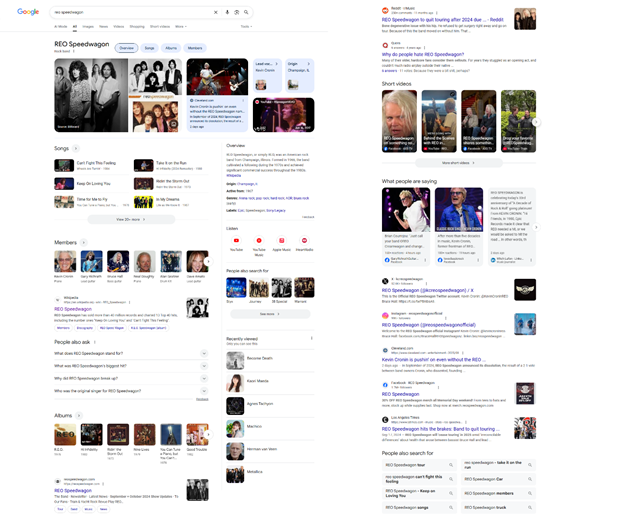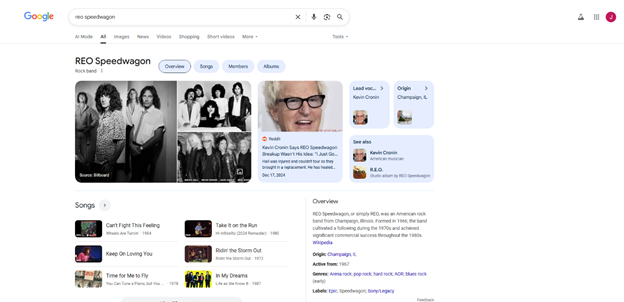The Times SEO Died (and Came Back Better Than Ever)
-

Jonas Trinidad
- Blogs
-
 August 19 , 2025
August 19 , 2025 -
 10 min read
10 min read
A mad scientist once said, “If I had a nickel for every time SEO ‘died,’ I’d have a couple of nickels, which isn’t a lot, but it’s weird that it’s happened that many times.” Okay, that’s not the exact quote, but how he wished he were a few nickels richer now.
It seems like when a major Google core update or some modern doohickey debuts, people are quick to sound the death knell for SEO. We’re seeing this right now with the shift toward AI summaries driving the decline of organic traffic. Ranking at the top of search results isn’t as important as it was several years ago.
But time and time again, the response from industry experts remains: SEO isn’t dead, it just changed. That doesn’t mean SEO is immortal; if search engines cease to exist, so will SEO.
That said, SEO practices and principles have changed over the years. As much as we like to keep them, trends don’t stay constant. Search engine algorithms must adapt to changes in consumer and business trends to maintain their usefulness. Without further ado, here’s an in-depth look at the times SEO “died” but returned better than ever.
PageRank
SEO didn’t start with Google.
The early 1990s witnessed the birth of the first generation of search engines, starting with WHOIS. It isn’t so much a search engine as it’s a query and response protocol designed to look up Internet resources. These include domain names, the site owner’s contact details, and DNS records. These are things that typical consumers today don’t search for.
To be fair, there weren’t many websites even after the first one was launched in 1991. For starters, Archie (widely credited as the first search engine) was limited to files and didn’t index their content due to data limitations. Instead, search engines at the time developed the building blocks from which their successors would be built decades later.
One of these was PageRank, the brainchild of then-Stanford University computer science students Sergey Brin and Larry Page. You can read their original paper here in its technical glory, but the gist is that PageRank uses a probability distribution model.
Each page has a PageRank score, and the total score of all pages on the Web can’t exceed 1. Increasing a page’s score occurs in three ways: it receives links from another page, links to said page in return, or both. If this sounds familiar, it’s link building in a nutshell, and the links (later known as backlinks) are a vote of confidence for the page.

Source: Ahrefs
It was later found that PageRank’s initial formula had flaws, particularly the sum of all the PageRank scores going over 1. Standard probability doesn’t permit a result greater than 1 or 100%. If it were, that’s a problem for quantum mechanics now. (1)
Nevertheless, PageRank was years ahead of its time. It formed the heart of Google upon its launch in 1998, a year following PageRank’s creation. It set the tone for the SEO discipline, its practices revolving around content quality and relevance. All of a sudden, practices like link spam and keyword stuffing no longer had a place in search.
Universal Search
Throughout the 2000s, Google added a range of new search features from Images to News. At first, users had to switch from one type of search to the next to use these features. Then, a Eureka moment hit the company: why limit content to just text?
The search engine results page (SERP) underwent a radical change in 2007. In addition to the so-called “blue links,” the page features various forms of relevant content, including images, videos, and news stories. It’s called Universal Search and would have enormous repercussions for SEO and search as a whole.
How? Well, look at it.

The whole page was split because it’s THAT long.
When Google said it wanted to make the world’s information accessible and useful to all, it wasn’t kidding. On the first page, you’re treated to a treasure trove of information. Images, relevant searches, news articles, videos, FAQs, social media posts; everything is just a click away.
But what made this kill SEO at the time was how the top organic result appeared.

It’s nowhere to be found above the fold. Depending on your screen resolution, anyway.
While it wasn’t this content-rich when first introduced, Universal Search put the blue links on the path to obsolescence. As more SERPs received the Universal Search treatment, the organic results were pushed down. What’s stopping users from just clicking on the media above if that’s precisely what they’re looking for?
Another effect is that content is no longer limited to regular webpages. Depending on the search intent, high-ranking results can now be images, videos, or even item listings. SEO for each medium differs, and professionals have to learn all of them.
Panda and Penguin
If you’ve been in the SEO business for a while, you know this was coming. PageRank and Universal Search may have impacted the discipline, but they pale in comparison to these two updates. They basically turned content creation on its head.
The Panda update, released in February 2011, was designed to target low-effort content. In addition to keyword and link spam, it would penalize copy-pasted content and content that added little to no value for the viewer. Site owners were advised to create content the same way journalists and researchers do: citing sources, offering professional insights, etc.
Panda made the bigger splash, affecting close to 12% of all search queries. Two weeks after Panda’s rollout, SEO analytics platform SISTRIX conducted a study that found the biggest losers suffered a search visibility drop of up to 94%. (2)

Source: SISTRIX
Demand Media was among the companies that received a rude awakening. Many of the biggest losers were websites that it owned, causing a USD$6.4 million loss in revenue in 4Q 2011. Its business model involved pumping out thousands of articles daily based on popular keywords, which Google said diluted the quality of search results. (3)
Over a year later, Google introduced its webspam algorithm update, popularly known as Penguin. Whereas Panda cracked down on low-effort content, Penguin hunted down low-quality links. Websites were no longer allowed to build links just to have links; they must also ensure the links are relevant and come from authoritative sources.
Penguin was spread out across six updates, gradually introduced over a four-year timeline. The updates affected 3.1% of English search queries (and 3% of non-English ones), but their impact was just as daunting as Panda. Below is the traffic for a site hit by Penguin. (4)

Source: Search Engine Journal
It was during this time that the phrase “SEO is dead” picked up steam. Up until the rollout of Panda, keyword stuffing and link manipulation—now black-hat practices—were all that most site owners knew. Google was looking ahead with these updates, seeing that search engines would be more relied upon for people’s content needs.
Mobileggedon
The original iPhone was revolutionary for its time, packing the computational power of a desktop PC in the palm of one’s hand. Coupled with the ability to download and install apps from the App Store, it was capable of doing virtually anything. While no data on how many units were sold over its year-long run exists, it nevertheless changed mobile forever.
By the 2010s, smartphones were rapidly becoming the means of mobile communication. While most Americans still used cellphones, the share of smartphones picked up over the decade. Pew’s first survey on smartphone ownership in 2011 recorded a 35% share, but it grew to 91% by the first half of 2024. (5)
Google was right to anticipate the rise of smartphones, but not just for calling and texting. It envisioned a time when mobile users could search for and access content outside their homes, and the smartphone’s versatility could make it happen.
In 2015, Google introduced an algorithm update that favors sites with mobile-friendly versions. Site owners now need a website that’s just as readable and user-friendly on mobile as it is on desktop. The update only affects SERPs for mobile search, which is distinct from conventional search. (6)
The Internet was still reeling from the Panda and Penguin sweep, so some site owners were understandably nervous. However, data from Moz showed that many sites had anticipated the update, with around 70% of first-page results tagged as “mobile-friendly.”

Source: Moz
SEO experts expected “Mobilegeddon,” released on April 21, to hit just as hard as Panda and Penguin did. Despite a few days being hotter than usual, Moz assessed that mobile search temps remained largely stable.
Does this mean there wasn’t anything to kill here? There was.
The update killed the then-prevailing mindset that SEO focused on desktop websites. Many site owners happened to get the memo after Panda and Penguin scared the living daylights out of them. A website that lacks a mobile presence misses out on a major source of leads, which has only grown more true today.
Artificial Intelligence
Finally, we return to the technology responsible for amplifying the “SEO is dead” voices. You can read more about it in my post on AIO, GEO, or LLMO—whatever you guys call it, but the gist is that AI threatens to end organic SEO as we know it.
To which I say, pretty much.
Then again, if you’ve read this far into the article, you should know that AI isn’t primarily to blame. The updates we’ve discussed have already made certain SEO practices unviable. Universal Search killed the blue links, Panda and Penguin killed low-effort content and link building, and mobile-friendly updates killed desktop-centric SEO.
Yet, such practices persist because old habits die hard (plus Google’s core updates can sometimes be vague on the changes). If AI did screw your SEO strategy, either it mostly relied on ineffective shortcuts or you didn’t have one to begin with.
The introduction of AI to search is to make us step up our SEO game. People may no longer click on results or prefer mobile over desktop, but I don’t see search engines going the way of the dodo anytime soon. They’re still used to search for answers; the difference is that the answers come more quickly.
Expect More SEO ‘Deaths’ in the Future
SEO isn’t so much dead as it has already died multiple times. The next ‘death’ may just be around the corner, but phasing out practices won’t kill SEO as a whole. It changes with the user, just as it has always been.
References
1. Stox P. Google PageRank is NOT Dead: Why It Still Matters [Internet]. SEO Blog by Ahrefs. 2018. Available from:https://ahrefs.com/blog/google-pagerank
2. Finding more high-quality sites in search [Internet]. Official Google Blog. Available from:https://googleblog.blogspot.com/2011/02/finding-more-high-quality-sites-in.htm
3. Pham A. Demand Media posts $6.4-million loss in fourth quarter [Internet]. Los Angeles Times. 2012 [cited 2025 Aug 15]. Available from:https://www.latimes.com/business/la-xpm-2012-feb-17-la-fi-0217-ct-demand-media-20120217-story.htm
4. Google. Another step to reward high-quality sites [Internet]. Inside Search. 2012 [cited 2025 Aug 15]. Available from: https://search.googleblog.com/2012/04/another-step-to-reward-high-quality.html
5. Pew Research Center. Mobile fact sheet [Internet]. Pew Research Center. 2024. Available from:https://www.pewresearch.org/internet/fact-sheet/mobile/
6. Rolling out the mobile-friendly update | Google Search Central Blog [Internet]. Google Developers. Available from:https://developers.google.com/search/blog/2015/04/rolling-out-mobile-friendly-update
Subscribe to Our Blog
Stay up to date with the latest marketing, sales, service tips and news.
Sign Up
"*" indicates required fields


